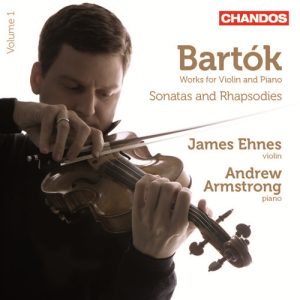 |
 |
|


alternatively
CD: MDT
AmazonUK
AmazonUS
Download
from The Classical Shop |
Béla BARTÓK
(1881-1945)
Works for Violin and Piano - Volume 1
Rhapsody No. 1, BB 94a [10:25]
Sonata No. 2, BB 85 [20:07]
Rhapsody No. 2, BB 96a [10:33]
Sonata No. 1, BB 84 [33:35]
Andante, BB 26b [4:00]
Alternative ending for Rhapsody No. 1 [1:48]
 James Ehnes (violin)
James Ehnes (violin)
Andrew Armstrong (piano)
rec. Potton Hall, Dunwich, Suffolk; 30 May - 1 June 2011
 CHANDOS CHAN10705 [80:30]
CHANDOS CHAN10705 [80:30]
|
|
|
I’ve spent a lot of energy recently praising to
the skies James Ehnes’ work as a concerto soloist, both
live in Edinburgh
and on disc with Tchaikovsky.
He is a musician of the most outstanding calibre, and this CD
of his work in Bartók will only raise his reputation
higher.
The title of the disc suggests that Ehnes and Armstrong are
embarking on a project, though no further details are given
in the liner-notes. If so then it’s one worth keeping
an ear on, as the results on display on this disc are extraordinary,
a worthy successor to his disc
of Bartók concertos, also on Chandos. Bartók’s
violin sonatas are among his most interesting but challenging
works, and it’s a master-stroke to couple them with some
of his most accessible writing for violin and piano. The disc
begins with the first Rhapsody which, with its fiercely rhythmic
opening, is immediately stamped with the flavour of Hungarian
folk dance. In fact, the composer even refers to this in his
sub-heading for the work: Folk Dances. The first movement
has an earthy quality to its main melodies but a lovely songful
feel to the great central section. The second movement is more
showy, perhaps even more indebted to the composer’s love
of Hungarian folk tunes. It’s full of dazzling inflections
tossed off by Ehnes as if it were all in a day’s work.
For the sake of completeness the disc also supplies an alternative
ending which is interesting enough, if a bit superfluous. The
Second Rhapsody is more angular than the first with some astonishing
double-stopping from the soloist but also some bright-eyed humour
too.
Make no mistake, though, the main events here are the two sonatas.
It’s a shrewd programming move to put the more approachable
Second Sonata first. The playing here is imbued with a lovely
sense of questioning, of exploration, especially in the violin
line. The piano underpins it with something more adamant, still
exploring but more insistently than his partner. There is a
lovely sense of the two listening to one another, as it should
be in all the best sonata performances. The second movement
is more reckless than the first, runaway and playful in many
places, especially in the regular violin glissandi and double-stops,
but always maintaining a hint of an edge. I loved the interplay
of the pizzicato violin with the grumbling piano just before
the lightning quick perpetuo section. The listener is
treated to two great artists striking sparks off each other.
The ending is particularly sublime, played with beautiful subtlety
as the violin heads gently into the stratosphere.
The angular dissonant landscapes of the First Sonata present
more of a challenge to the listener, but Ehnes and Armstrong
assail this terrain with breathtaking skill. The spiky, often
discordant world of the opening gives way to a slow movement
of astounding humanity, the stillness coming across all the
more powerfully after the drama of the opening, and the unaccompanied
violin line that opens this movement draws the finest playing
on the disc. It’s followed by a finale whose energy and
attack will knock your socks off. Then, as if to surprise us
all, the disc ends with the earliest, and most instantly accessible,
work of all, the Andante that the composer wrote for
the Arányi sisters who were the great-nieces of Joseph
Joachim. Its arching, lyrical melody is beautiful in its simplicity,
played here with intense beauty and just the right degree of
schmaltz.
This is a magnificent disc, wonderful playing captured in fantastic
sound, and a fine way to begin an exploration of Bartók’s
work in this genre. Roll on Volume Two.
Simon Thompson
see also review by Leslie
Wright
|
|

